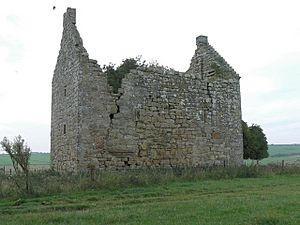Pittarthie Castle facts for kids
Quick facts for kids Pittarthie Castle |
|
|---|---|

Pittarthie Castle
|
|
| Designated | 29 October 2003 |
| Reference no. | SM870 |
| Lua error in Module:Location_map at line 420: attempt to index field 'wikibase' (a nil value). | |
Pittarthie Castle was once a strong, fortified home for a Scottish laird (a type of landowner). You can find its ruins in Fife, Scotland. It's about 2.5 kilometers (1.5 miles) southwest of Dunino and 6.5 kilometers (4 miles) northwest of Anstruther. Today, these old ruins are a protected site, known as a scheduled monument, which means they are important historical remains.
The Castle's Past: Who Lived Here?
Building the Castle: The Monypenny Family
The castle you see today was built around 1580. It was first built for a man named James Monypenny, who was from Pitmilly. Later, the King officially gave the lands of Pittarthie, including the castle, to Andrew Logan and his family. James Monypenny had given up his rights to the property, which he had held from the Archbishop of St. Andrews.
New Owners: The Bruce Family Arrives
Around 1636 or 1644, the Bruce family bought the Pittarthie estate. William Bruce of Pittarthie made big changes to the house in 1653. Just one year later, in 1654, William Bruce officially inherited the property from his father, Andrew Bruce.
What It Looked Like Long Ago
In 1882, people described "Pittairthie Castle" as a roofless ruin. They noted that parts of it were very old, while other parts were built in 1653. The oldest part was a large square tower with vaulted rooms underneath. The very old sections might have been built even earlier than the 1580 castle. This is suggested by the rougher stone found at the bottom of the south wall. Some reports say the estate itself dates back to the 1300s. After about 1700, the property may have passed to the Hannay family of Kingsmuir.
Exploring the Castle Ruins Today
Castle Shape and Materials
Today, a lot of the hilltop house still stands. It's built in an "L" shape, which is a common design for castles. The shorter part of the "L" (called the jamb) has a rounded corner on its northwest side. A stair tower is tucked into the inner corner of the "L" shape. The castle was built with good quality rubble stone, which means rough, broken stones. It also has ashlar dressings, which are finely cut stones used around windows and doors. The very bottom of the south wall has much rougher stone, which might be a clue that an even older building was there before.
Defenses and Decorations
The castle still shows off some cool, old defenses. There's a gunloop (a small opening for a gun) right next to the main door. You can also see pistol holes under all the window sills. These were for defending the castle.
Carvings and Windows
You can find the date 1682 carved above a window on the first floor. This carving also shows William Bruce's family crest and his initials. Most of the windows have rounded edges, which was a popular style in the late 1600s.
Inside the Castle
The inside of the castle is now empty and falling apart. In the tunnel-vaulted jamb (the shorter part of the "L"), there was a kitchen. It had a huge fireplace on the north side and a place for water to come in on the west wall. A stair turret (a small tower with stairs) on the north side might have been added around the late 1600s too.
Finding Pittarthie Castle on a Map
Modern maps show the ruins of Pittarthie Castle in a field southwest of Dunino. It's not far north of Carnbee. You can also find Pittarthie Castle on some popular maps that show castles in Scotland.

